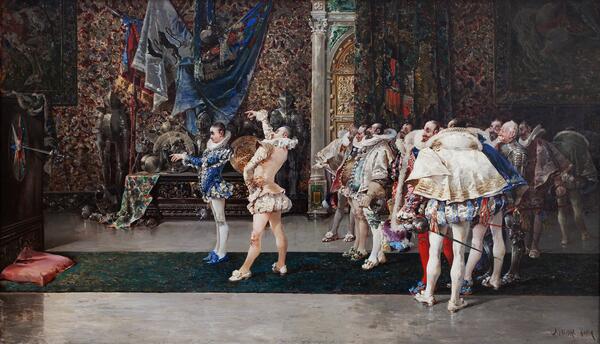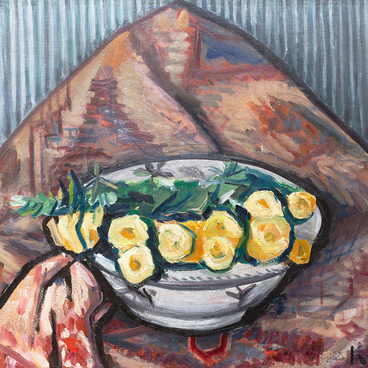Baldomero Galofre y Giménez is a 19th-century Catalan painter and watercolorist. He graduated from the Catalan Art School in Barcelona and the Academy of Fine Arts in Rome.
Baldomero was a realist painter. He created paintings on historical themes, scenes from everyday life, mountain and seascapes.
Later, Impressionism greatly influenced his style, specifically, the works of another Catalan artist — Mariano Fortuny, who was called the ‘harbinger of Impressionism’. Baldomero adopted his techniques of working with subtle color combinations (color saturation, brightness, chiaroscuro) and careful drawing of details. However, he did not lose his own style: he used bright colors and painted canvases in short brushstrokes, which gave his works saturation and texture.
The painting ‘Javelin Throw’ was created by Galofre y Jimenez Baldomero at the turn of the 19th century. The theme of the canvas is connected with the prohibition of bullfighting in the 18th century. King Philip V did not approve of bloody and cruel sports. He could not completely ban the popular bullfighting: his position would not have withstood the people’s anger. Therefore, the king only forbade equestrian bullfighting. This turned out to be enough for the grandees — the so-called representatives of the upper nobility — to start looking for other hobbies, and bullfighting transformed into an entertainment for commoners. They went out against bulls on foot with swords. Later, Charles III tried to ban bullfighting, however, under his son, Charles IV, the interest in bullfighting among the nobles increased again.
The painting depicts aristocrats who gathered in the Hall of Military Glory around the target. One of them demonstrates his skills and gives a lesson to a young grandee. The heroes of the canvas are depicted in pretentious and theatrical poses, although their game resembles darts rather than training.
The style of the interior design is characteristic of the heyday of the Spanish state: the hall is decorated with carvings, gilding, expensive carpets, and tapestries depicting military scenes. The costumes of the characters are somewhat exotic for the artist’s contemporaries: short puffy trousers, large lacy collars. These clothing items were typical for the costumes of the 16th-century Spanish nobles.
Paintings by Baldomero Galofre are a rarity for any Russian museum. Until 1918, the painting ‘Javelin Throw’ belonged to the family of Vasily Soldatyonkov, the nephew of the famous Moscow collector and book publisher Kozma Soldatyonkov. Then it entered the Moscow State Museum Fund and was later transferred to the Tomsk Museum.
Baldomero was a realist painter. He created paintings on historical themes, scenes from everyday life, mountain and seascapes.
Later, Impressionism greatly influenced his style, specifically, the works of another Catalan artist — Mariano Fortuny, who was called the ‘harbinger of Impressionism’. Baldomero adopted his techniques of working with subtle color combinations (color saturation, brightness, chiaroscuro) and careful drawing of details. However, he did not lose his own style: he used bright colors and painted canvases in short brushstrokes, which gave his works saturation and texture.
The painting ‘Javelin Throw’ was created by Galofre y Jimenez Baldomero at the turn of the 19th century. The theme of the canvas is connected with the prohibition of bullfighting in the 18th century. King Philip V did not approve of bloody and cruel sports. He could not completely ban the popular bullfighting: his position would not have withstood the people’s anger. Therefore, the king only forbade equestrian bullfighting. This turned out to be enough for the grandees — the so-called representatives of the upper nobility — to start looking for other hobbies, and bullfighting transformed into an entertainment for commoners. They went out against bulls on foot with swords. Later, Charles III tried to ban bullfighting, however, under his son, Charles IV, the interest in bullfighting among the nobles increased again.
The painting depicts aristocrats who gathered in the Hall of Military Glory around the target. One of them demonstrates his skills and gives a lesson to a young grandee. The heroes of the canvas are depicted in pretentious and theatrical poses, although their game resembles darts rather than training.
The style of the interior design is characteristic of the heyday of the Spanish state: the hall is decorated with carvings, gilding, expensive carpets, and tapestries depicting military scenes. The costumes of the characters are somewhat exotic for the artist’s contemporaries: short puffy trousers, large lacy collars. These clothing items were typical for the costumes of the 16th-century Spanish nobles.
Paintings by Baldomero Galofre are a rarity for any Russian museum. Until 1918, the painting ‘Javelin Throw’ belonged to the family of Vasily Soldatyonkov, the nephew of the famous Moscow collector and book publisher Kozma Soldatyonkov. Then it entered the Moscow State Museum Fund and was later transferred to the Tomsk Museum.



